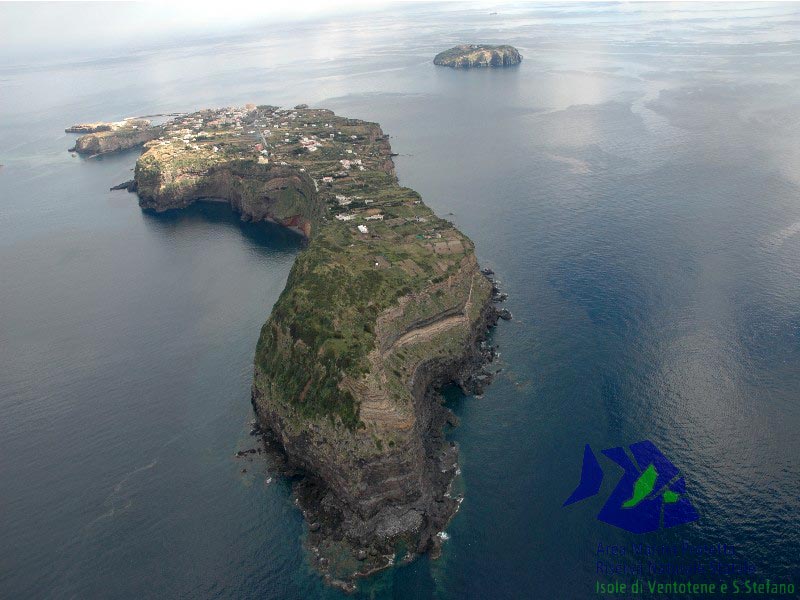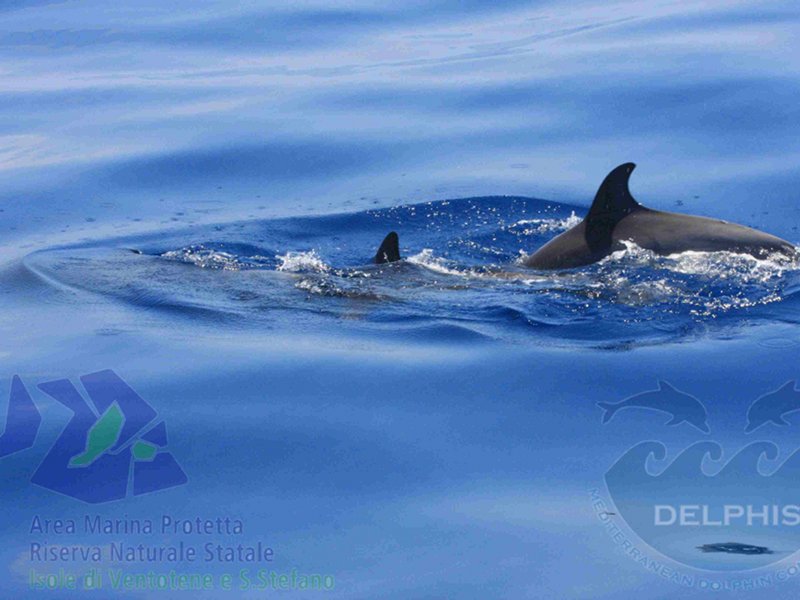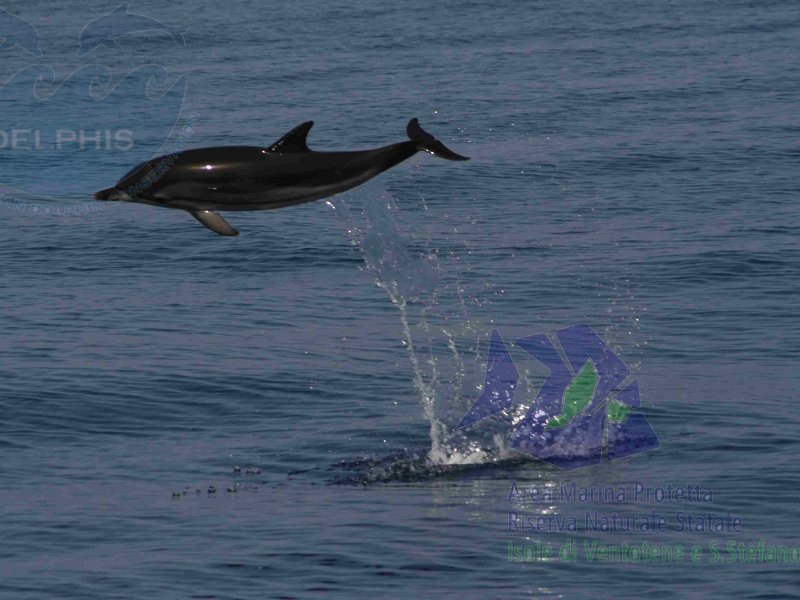Area Marina Protetta Isole di Ventotene e Santo Stefano
www.riservaventotene.itProtected Area
Identity Card
- Isole di Ventotene e Santo Stefano Marine Protected Area:
- Park Authority: Comune di Ventotene (Ente Gestore AMP/RNS)
- Further managed Protected Areas:
- Riserva Naturale Statale Isole di Ventotene e Santo Stefano
- ZSC Fondali circostanti l'Isola di S. Stefano
- ZSC Fondali circostanti l'Isola di Ventotene
The "Ventotene and S. Stefano Islands" Marine Protected Area
Purposes
The "Ventotene and S. Stefano Islands" Marine Protected Area in particular pursues:
- the environmental protection of the marine area concerned;
- the protection and enhancement of the biological and geomorphological resources of the area;
- the diffusion and dissemination of knowledge of the ecology and biology of the marine and coastal environments of the natural marine protected area and of the peculiar environmental and geomorphological characteristics of the area;
- the implementation of educational programmes for the improvement of general culture in the field of ecology and marine biology;
- the implementation of study and scientific research programmes in the fields of ecology, marine biology and environmental protection, in order to ensure systematic knowledge of the area and the impacts of human activities;
- the promotion of a socio-economic development compatible with the naturalistic importance of the area, also favouring traditional activities already present;
within the framework of the promotion of a development compatible with the above-mentioned aims, for the activities related to the channelling of tourist flows and guided tours, the determination of the relevant rules shall provide for specific facilities for collective means of transport operated preferably by citizens resident in the Municipality of Ventotene.
Piazza Castello, 1 - 04031 Ventotene (LT) Ph. +39 0771/854226 - E-mail: info@riservaventotene.it
Marine Biology
Ventotene's seabed is characterised by ravines and recesses, which are also favoured by the erosion process that causes periodic landslides. This particular morphology, associated with the inaccessibility of long stretches of coastline from land, favours a particular ecosystem in which there is a great variety of benthic organisms. The presence of caves and landslides also creates shallow water environments that are home to species typical of deeper waters. The underwater landscapes of Ventotene are dominated by colours such as dark green, dark red or violet, which are determined by the presence of coelenterates, porifers and various species of encrusting algae. The vaults of the caves are often brightened by the orange colour of the yellow cluster anemones, and here it is possible to encounter nocturnal animals such as octopuses and moray eels. Near the sandy areas up to 40 metres, there are large prairies of Posidonia oceanica, an important superior plant of our sea, in particular for its "barrier effect" capable of slowing down wave motion and protecting the coastline from erosion. Seemingly monotonous, posidonia meadows are fascinating because of the large number of micro-environments they offer.
One hectare of posidonia beds can host more than 350 species of invertebrates and fish, not counting algae and microorganisms. In this environment, it is easy to see young red mullets or suspicious pearly razorfish, and if you look closely you can spot small brills, Atlantic lizardfish and the perfectly camouflaged weeverfish, half-submerged in the sand. The position of the island of Ventotene, far from the mainland and with a profile that descends rapidly to a depth of more than fifty metres, means that pelagic organisms can be encountered even close to the coast, such as large fish (great amberjacks, tuna, common dolphinfish, leerfish, etc.). Cetaceans have also been reported from time to time: sperm whales (Physeter macro-cephalus), stenellas (Stenella coeruleoalba), common dolphins (Delphinus delphis) and long-finned pilot whales (Globicephala melaena). The loggerhead sea turtle (Caretta caretta) has also been sighted frequently.
Greenery
Originally covered by holm-oak woods (evergreen woods with a prevalence of Q. Ilex) inside and by Mediterranean scrub along the coast, the Ventotene greenery today appears to have been profoundly modified by human activity and only in a few places does the autochthonous vegetation survive.
Since the first colonisations in the 18th century, man has profoundly modified the island's territory. Initially by promoting the deforestation of the land and then causing its degradation until the appearance of garrigue, a process that began with the practice of fires; converting part of the land to vegetable crops such as lentils and finally with the introduction of exotic plants (prickly pears, agave and aloe, etc.), originally used on the edges of the crops to protect them from the winds, together with black mulberry, hottentot-figs, etc. Many of these plants can now be found in less cultivated areas as they are now naturalised on the island. In the most degraded areas, broom, inula, ferula, wild thistles, wild carrot, brambles, etc. dominate.
However, in some areas of the island (Punta dell'Arco), on the slopes overlooking the sea and difficult to cultivate, one can observe examples of the island's original vegetation: holm oak, lentisk, myrtle, juniper, tree spurge, artemisia, rosemary, Mediterranean honeysuckle, etc. There are also rare plants such as the European fan palm (Chamaerops humilis), present in only one station at Punta dell'Arco and various endemic forms, such as the cliff cornflower (Centaurea cineraria, in its pandataria variety), and three small Plumbaginaceae: the Limonium pontium variety and the pandataria variety and the Limonium multiforme in the sanctistephani variety, the latter only present on the islet of S. Stefano, on the cliffs near the sea.
Ornithology
In spring, migratory birds that have spent the winter in Africa head north to nest and find themselves having to fly over the Mediterranean Sea after the desert, which represents a risky ecological barrier. In order to study the importance of Mediterranean islands as stopover sites for migratory birds, since 1988 the Istituto Nazionale per la Fauna Selvatica (INFS) has been coordinating the PICCOLE ISLANDS PROJECT (PPI), which is based on a dense network of island and coastal stations distributed throughout the Mediterranean. Standardised ringing activities are carried out on these, according to internationally accepted protocols. The ringing technique allows the individual marking of birds by means of a very light ring on the leg, and enables the study of their migration routes and life history. As part of this vast project, Ventotene has, from the beginning, been a site of extraordinary ornithological importance, with the ringing of over 150,000 birds belonging to around 100 different species. Actually, the island hosts huge numbers of birds that left the previous evening from the coast of North Africa, flew continuously during the night, and are still at sea at daybreak. As a true birding hotspot, Ventotene is visited by birds heading for vast geographical areas, ranging from western and northern Europe to eastern Russia. Migratory birds use the island for short stopovers, but this is an important part of their long journey.
During the hours they spend on Ventotene, they rest after such a great energy effort and feed abundantly on the nectar offered by the flowers that colour the scrub in spring. The energy offered by the sugar contained in the nectar allows these birds to recover energy and then resume their journey to their breeding grounds. Among the species that nest on the island, those of particular naturalistic value are the Scopoli's Shearwater (Calonectris diomedea), the Manx Shearwater (Puffinus yelkouan) and the Peregrine Falcon (Falco peregrinus). The remarkable and unquestionable natural heritage of the two islands has led to Ventotene and Santo Stefano being identified first as SPAs and SCIs (Special Protection Areas and Sites of Community Importance), and then as a State Nature Reserve.
Geology
The Pontine archipelago was formed between the end of the Tertiary and the early Quaternary, i.e. between 3 and 1.3 million years ago. The formation of Ventotene began about 1,700,000 years ago with huge volcanic eruptions and ended about 500,000 years later with a violent phreatomagmatic explosion that destroyed part of the volcano cone, which today would be located one mile off Punta dell'Arco. Ventotene and S. Stefano differ from the other islands of the archipelago both chronologically, as they are more recent, and geologically, as they are formed by different types of rocks due to a more basic type of magmatism. Ventotene's size and shape were initially very different from what it is today. Marine and wind erosion have shaped the island and continue to modify its contours. Going around the island, starting from Punta dell'Arco, the south-west point and highest part of the island, we come across a high layer of black basaltic rocks, formed by a large lava flow, on which a layer of ash and lapilli was later laid, forming the tuffaceous core of the island. Proceeding towards Cala Nave, we can see a tormented outline and on some of the walls we can observe the entire stratigraphic series of deposits, clearly differentiated from each other also in colour, from yellow to red and gradually going down to a darker colour, compact and solid. The northern end of Ventotene, from the rocks of the lighthouse to Punta Eolo, is composed of an imposing tuffaceous complex formed by eruptions subsequent to those that created the first nucleus.
Concluding the tour of the island from Punta Eolo to Punta dell'Arco, we find a similar aspect on the opposite side, with the presence of a deep inlet called Parata Grande. The Ventotene orography is characterised by suspended valleys and vertical cliffs, and the coast has several cliffs, protruding promontories and large lands of black basalt in the sea, remnants of rock following the erosion of tuff.
Flora and Fauna
Biocoenosis
- Field of Cymodocea nodosa
- Meadow of Posidonia oceanica
- Coralligenous facies with Paramuricea clavata
- Coralligenous Biocoenosis
- Infralittoral scyphilous population on rocks with biological concretion (Precoralligenous)
- Calcareous Crustose Rhodophytic Biocoenosis
- Photophilic biocoenosis of Upper Infralittoral Rock in Moda Calma without a high layer of Fucales
- Photophilic biocoenosis of Upper Infralittoral Rock in Moda Calma with Cystoseira
- Photophilic biocoenosis of the Infralittoral Rock in Moda Battuta
- AMP Benthic biocoenosis
- Coarse Sands biocoenosis
- Biocoenosis of the Well Classified Fine Sands
- Biocoenosis (trottoir Vermetus)








